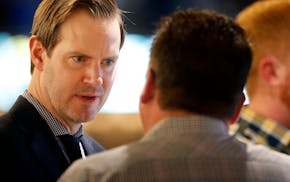Trevor Hildenberger was a standout pitcher at Archbishop Mitty High School in San Jose, Calif., and was recruited to Cal-Berkeley on a scholarship. He pitched two innings as a freshman in 2010, did not pitch in what became a redshirt season in 2011, and "around 10 innings'' as a sophomore in 2012.
"I had to be a disappointment as a pitcher for the coaches, and I know I was a disappointment to myself,'' Hildenberger said.
The real emotional blow as a competitor came in 2011, when the Golden Bears reached the College World Series.
"Our pitching staff was stacked, and I wasn't good enough to be part of it,'' Hildenberger said. "I warmed up once … in an 18-inning game. I was going in for the 19th, if the game hadn't ended. I watched the World Series from my couch in California."
There's generally a story as to how a pitcher becomes a sidearmer. Most often, it's due to an injury, and the search for a comfortable arm slot. Pat Neshek developed his submarine style after a wrist injury as a high school senior.
There was no such malady involved in Hildenberger's transformation from an overhand pitcher with mediocre stuff to the sidearm style that has made him a vital ingredient in the Twins' unlikely push toward the 2017 postseason.
California was practicing after the 2012 season. An infielder showed up wearing No. 37, and coach Dave Esquer said that number was more suited for a corner outfielder.
Hildenberger was wearing No. 26 and asked the coach for his impression of that number. Esquer mentioned that both UCLA and Washington had sidearm pitchers who wore that number, and this turned into a suggestion that maybe Hildenberger should try a bullpen session as a sidearmer.
"My pitches had better movement throwing from the side, and the coaches said, 'OK, start throwing that way and we'll see what happens,' " Hildenberger said.
He became a serviceable pitcher for the Bears in 2013, with a 5-4 record and a 5.31 ERA in 26 games.
"I had been in school for four years and had the credits I needed,'' Hildenberger said. "I was going to finish up and find a job.''
Late that summer, the Bears had a recruit sign after being drafted. Hildenberger said: "The coaches called and said, 'We have some scholarship money we didn't expect. You want to come back?' ''
Hildenberger shrugged and said: "Another year of baseball. Why not?"
He was sitting outside the Twins' clubhouse at midafternoon Friday. That one more year at Cal — 28 games, 10 saves, a 2.83 ERA — turned into being selected in the 22nd round by the Twins in the 2014 draft.
He was an All-Star in the Class A Midwest League and in the Arizona Fall League in 2015. He was an All-Star in the Class AA Southern League in 2016.
In late June, Doug Mientkiewicz, his manager with Chattanooga, said: "If he's not in the big leagues by the end of the year, I'll be surprised.'' In late July, tendinitis in his flexor tendon sent him to the disabled list. Soreness in the flexor tendon often has been a symptom of an elbow ligament that's ready to tear.
"The MRI showed the ligament was fine,'' Hildenberger said. "Chad Jackson, the rehab trainer in Fort Myers, gave me some exercises for the flexor. I've had no problems since.''
That has been very good news for Paul Molitor. Hildenberger was added to the roster on June 23. As the Twins' pursuit of the postseason has become more earnest, the manager has become very reliant on the rookie.
"He's not strictly a sidearmer,'' Molitor said. "He throws three or four pitches from different arm angles. That can make him a handful for any hitter.''
Hildenberger didn't start throwing a changeup until the extra season at California. It has become his best pitch — inducing numerous horrible hacks from big-league hitters.
"We don't want to push him too hard, but he will take the ball,'' Molitor said. "We used him three days in a row earlier this month, and he was fine.''
Earlier Friday, Neshek was contacted and asked if he had watched Hildenberger. "No, but I'll go look at some video and get back to you,'' said Neshek, with Colorado after being an All-Star for the Phillies this summer.
Hildenberger said: "I watch closely all the pitchers who throw from the side. Neshek had a heck of career. Let me know if he has any advice.''
Pat's sidewinding advice would probably be this: Don't spin a backdoor slider in the middle of the plate to a lefthanded hitter.
Patrick Reusse can be heard 3-6 p.m. weekdays on AM-1500. • preusse@startribune.com

Reusse: Success on court helped Timberwolves do strong business

Reusse: Taylor's story. 'I just bought the Minnesota Timberwolves.'

Reusse: Back from injury, Towns doesn't have to carry load


